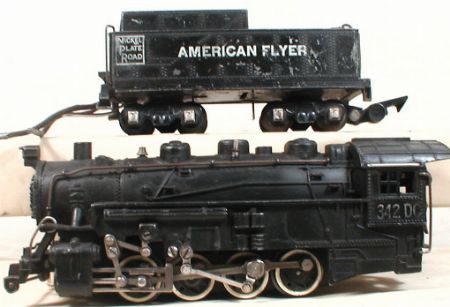
This is the most common version of American Flyer’s popular 0-8-0 switcher. The DC in 342DC means it doesn’t have a reverse unit and was wired for DC operation.
This was made between 1946 and 1952. The 342DC shown above is the last one from 1952.

This is the most common version of American Flyer’s popular 0-8-0 switcher. The DC in 342DC means it doesn’t have a reverse unit and was wired for DC operation.
This was made between 1946 and 1952. The 342DC shown above is the last one from 1952.

Lionel put a whistle into the little lithographed sheet metal station in 1937 and numbered it the 48W.
The station was originally sold in green litho with a transformer in it with the Winner line.
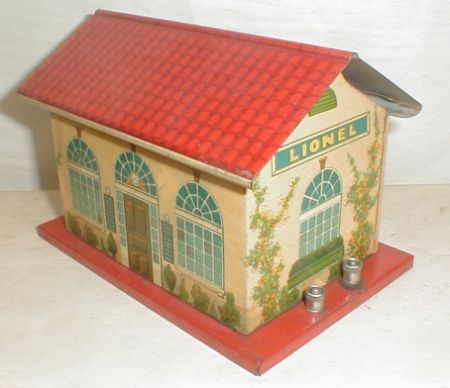
The 48W allowed kids with trains that didn’t have whistles to add whistles to their layouts. This was a cheaper option than buying an extra tender with a whistle.
The box for this station is rarer than the item itself. The box is just flimsy cardboard and didn’t survive.
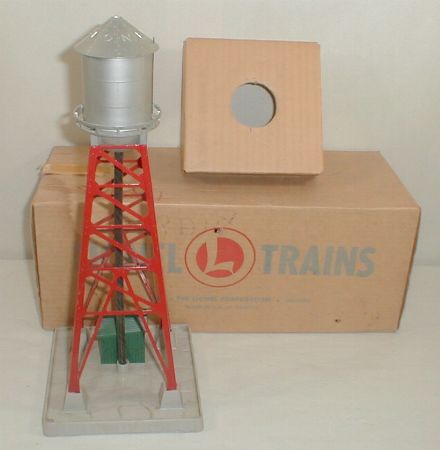
Lionel made the 193 industrial water tower from 1953 to 1955. The light on the top of the tank blinks.
There is supposed to be a red lens on the top of the tank. It’s the same part as the lights on the 252 crossing gate.
The tower comes with either red or black or black sheet metal structures. Red is shown above. Black brings a premium.
Copies of this tower have been made recently by Lionel and MTH.

American Flyer made this interesting accessory for only three years. Catalog number 23791 cow on track.
The operator pushes the red button on the controller and the cow swings out over the track. The train stops before hitting the cow. When the green button is pushed the cow swings away from the track and the train starts up again.
Many of these when found are melted. There is a resistor under the green base that blocks off most of the current so the reverse unit won’t cycle. If the cow is left over the track for long periods of time, the resistor gets hot and melts the base.

Lionel introduced the merchandise container in 1930. They were sold in a set of three, and designed to fit into the 212 and 512 gondolas. They were cataloged through 1938, but probably weren’t made after 1934. Lionel changed the plates from brass to nickel in late 1934, and these are only found in brass.
There is supposed to be a paper label in the top of the door saying “Manufactured under license granted by LCL Container Corp.,” but it’s missing from the one shown here. LCL stands for “Less Than Carload.”

Until 1932 they came with chains as shown here. After 1932 the containers were sold without chains. I think you got one set of chains with three containers. The containers could be lifted from gondolas with a 219 crane.
Here’s a close up with the door open:

Reproductions of these have been made by at least two companies. MTH and T-Reproductions. The box with three containers is somewhat rare and a nice set with a crisp box will bring a small premium.
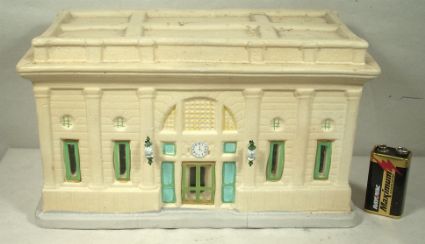
I saw a building similar to this about 15 years ago. I’ve been looking for one since then. This is a small Japanese – it’s marked “Made In Japan” on the bottom – Christmas building. Probably from the 1930s.
It’s made of plaster of paris.
The one I saw years ago was about half the size of this one. This one is much more detailed. It has added window frames, doors, and clock.

It’s painted in the early Lionel colors meaning it was copied from a station Lionel made before 1935. In 1935 Lionel changed the color of the station to red and white and added train control to make the 116 station.
It has a small hole in the back so you can stick a Christmas tree light into it.

I’d like to get the smaller one.
There are all kinds of Japanese made Christmas buildings around. Some are paper or cardboard, some are composition, and some are plaster. These are commonly called Putz buildings.

Lionel added remote control couplers to the 814R reefer in 1938 to create the 2814R refrigerator car.
Two versions were made; both are shown on this page. The earlier white with blue roof is more common than the later rubber stamped car.

White with Blue Roof and Nickel plates 1938-40
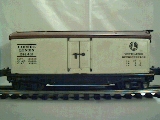
2814R Flat white with tuscan roof and rubberstamped lettering.

Lionel introduced the 814R refrigerator car in 1929 in the ivory and peacock color scheme. Because this car was not made in 1926 no short wheel base cars exist.
In 1934 the color was changed to white with a light blue roof. The white and blue cars were made until 1940, when the flat white and tuscan cars replaced them. The first run of flat white cars had nickel plates- not shown, but I’ll add a picture as soon as I can buy or borrow one. The rest of the flat white/tuscan cars had rubberstamped lettering.
The flat white/tuscan 814R with nickel plates or with rubberstamped lettering is the hardest reefer to find. Both version of the flat white car are among the hardest Lionel 800 series cars. Personally, I think the one with nickel plates is harder because I have a rubber stamped one.
The other refrigerator cars are common with the exception of the cars from 1934 and 1935 with mixed trim.
While many collectors get excited about the aluminum frame cars, they are no more difficult to find than the earlier black frame cars.

Lionel 814R Ivory sides, peacock roof, black frame. Brass trim.
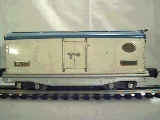
814R White, light blue, aluminum. Brass trim. 1935 notch car.

814R White, light blue, aluminum.
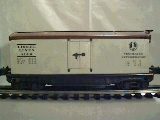
814R Flat white, tuscan, black. Rubberstamped lettering.
Lionel added remote control couplers to the reefer in 1938 and sold the resulting car as the 2814R
In 1938, Lionel added remote control couplers to the 813 stock car and introduced the 2813. The 2813 was made from 1938 through 1940, and came in cream and maroon only. The 2813 is not shown above but it looks the same as cream and maroon 813

The Lionel 813 Cattle car was introduced in 1926 in orange with a pea green roof.
In 1935, the color changed to cream and maroon. The cream and maroon car can be found with brass trim (harder to find) or with nickel trim.
In 1940, Lionel removed the nickel platesfrom the car and changed the color to tuscan with white rubber stamped lettering.The rubberstamped 813 is the hardest stock car to find; it is also one of the hardest regular production cars to find. Perhaps only 40-60 cars exist.
Here’s a guess as to why these cars are so hard to find: all of the cars I have examined-five- have holes in the ends. These holes are from the stamping dies, and correspond with where the embossed rivets should be. The rubber stamped cars are made of thinner galvanized metal, rather than the thicker tinplated metal used on the earlier cars.
I am guessing here, but perhaps the dies used to stamp the cars deformed the thinner metal of the car sides so that only a few of the stampings were useable? It would require a lot more pressure to stamp the slats in the car than to stamp rivet detail in the car ends.
Or, maybe Lionel had lots of cream and maroon cars in stock and didn’t start making tuscan cars until the war had started? I don’t know, but whatever the reason this is one rare car.
Some books say the rubber stamped 813 stock car is the rarest Lionel 800 series car. It’s not. The white/brown roof 814R reefer with nickel plates and the 816 black with rubber stamped lettering are both much harder to find.
The rest of the stock cars are easy to find with the orange and green car being really common. The 813 stockcar is the most commonly found short wheel base car. It is so common it won’t even bring a premium price over the normal wheelbase cars.
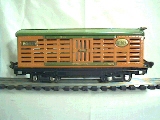
813 Orange sides, pea green roof, Brass trim.
This is a 1926 Short Wheel Base car.

813 Orange, pea green, brass.
Compare door handle on this car to larger handle on car above.

813 Cream, maroon, brass.
This is a 1935 car with mixed trim.
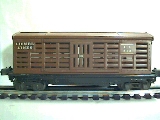
813 Tuscan, rubber stamped lettering.
In 1938, Lionel added remote control couplers to the 813 stock car and introduced the 2813.